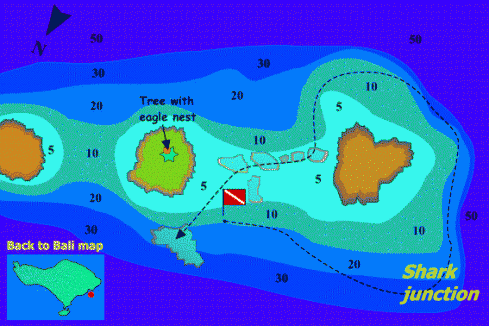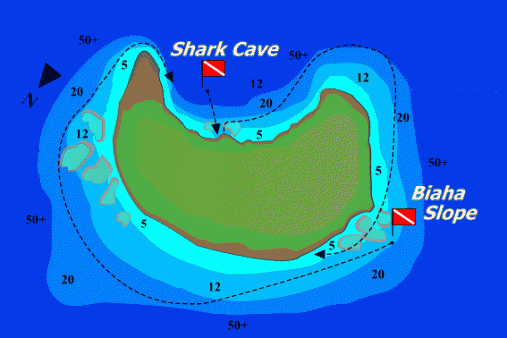The Amuk Bay
It is located offshore of Candidasa beach, 30 minutes access from Padang Bai harbour by motor boat. There are ranged of dive points scattered in this area namely Gili Mimpang (Shark Point), Gili Tepekong (Goat Island) and Gili Biaha (Shark Cave).
1. Gili Mimpang
Also known as the shark point amongst the diver society in Bali and one of the ideal dive sites about exploring reef sharks. The ragged boulder rocks in the row offshore offers reef slope from the depth of 6 meters down to 28 meters. The opposite is laying sandy bed in the depth of 30 to 40 meters where reef sharks flank on sand, they somehow swim around to the steep reef slope where the submerged boulder rock stands on 18 meters water, by the south end of the reef slope runs reef wall falling over 100 of meters which it considers danger of swirl current downward, before deciding further exploration to this part better have a good look to small fishes about swimming direction, they can be used to see the current direction and strength. On Sunfish season that started from around July to September, this creature frequently visits this site that have ever been reported by local home based Divemaster or Instructor. Fierce current occurred in this area when the tide is changing and better shift the dive destination to other location. The water temperature is relatively warm about 27 C and only get cold when the thermocline occurs.
2. Gili Tepekong
Gili Tepekong is the biggest offshore jagged boulder rock stood in Amuk Bay, its location is actually closer from Candidasa resort, but the access is difficult fro there due the reef barrier runs along the beach forming big wave lapping into the coastline. Therefore Padang Bay is the safest access to this site, fortunately easier get the boats from simple wooden fishing boats to modern fibre glass boats with variety of passengers capacity are available. There are two points interesting at this place Blue Hole (northeast) and Canyon (southwest).
a. Blue Hole
Blue Hole is actually huge boulder rock stands in 15 meters that inside has irregularly cracked hole end up in the blue water about 26 meters, the cracked hole itself lives swarm of reef fishes and some lobsters clink in the wall of the hole, passing through to the end should swim one by one in the row. On your left hand side is extended reef slope with some scattered bommies living abundance of reef fishes, sweetlipfishes, snapper fishes, and even napoleon wrasse. Reef shark is also common at this site. The current is changeable and can be shifted unpredictable, the best way could be done before diving is checking the current flows from the boat or enter the water without scuba to determine the entry point. Be always do predive orientation to ensure fun and safe diving. The water temperature is about similar to Gili Mimpang but sometime it can be cold around 24 C.
b. Canyon
Canyon is a striking structure of angular black boulders submerged in about 15 meters, corals are not well covered the site, attracting big school of Sweetlips, Jacks, big Groupers, and pelagic like Molas (Sunfishes), due a strong current swirls through it. To plan diving at this site is best to drop in next rock wall on the island’s western face, and head south and down slope, end up on the north protected side continues offshore to reach the canyon. To set diving at this site, first determine the water condition with viewing the wave breaking southwest corner, when it does so better not to dive because it swirls down current present and shifts the air bubble down like flashing water in toilet. The best thing can be done in such condition is clinking on the rock wall while wait the current shifting or possible to end up the dive and ascend at the northern side of the Canyon. Water temperature can be dipped into 20 C at this site, be ready with the proper wet suit and well equipped in exploring it.
3. Gili Biaha
This island is really a rock, with a rounded cap of grass and it is the most remote of the Amuk Bay sites, located about four kilometres northeast of Tepekong. It is beautiful a steep drop-off reef, nicely fissured and terraced in placed, rings most of the island, going to a slope in the north. The inside of the island’s curve is always protected from the current, but heavy swell can make things worst up near the reef wall face, particularly for your boat captain picks the divers up. End of the rugged and terraced reef wall will lead into blowhole where number of Reef Sharks are always be found under the overhang of the blowhole wall, inside also lives abundance of lobsters in between the cracked wall. To dive into blowhole should you carry the quality of light, inside it is really dark. There are swarm of reef fishes at this site, the beautiful Mayer’s butterfly fish is rare through out of Bali reefs, is common in this site. It is the only possible penetrating into blowhole when a small surge laps the reef wall and no pounded water out from blowhole. The swirled current can be occurred at some places of this site, to be safe is to stay close to the reef wall face and ascends rather bit a distance from the reef wall face. The water temperature dips as below as 20 C and get ready with properly wet suit to stay warm.



